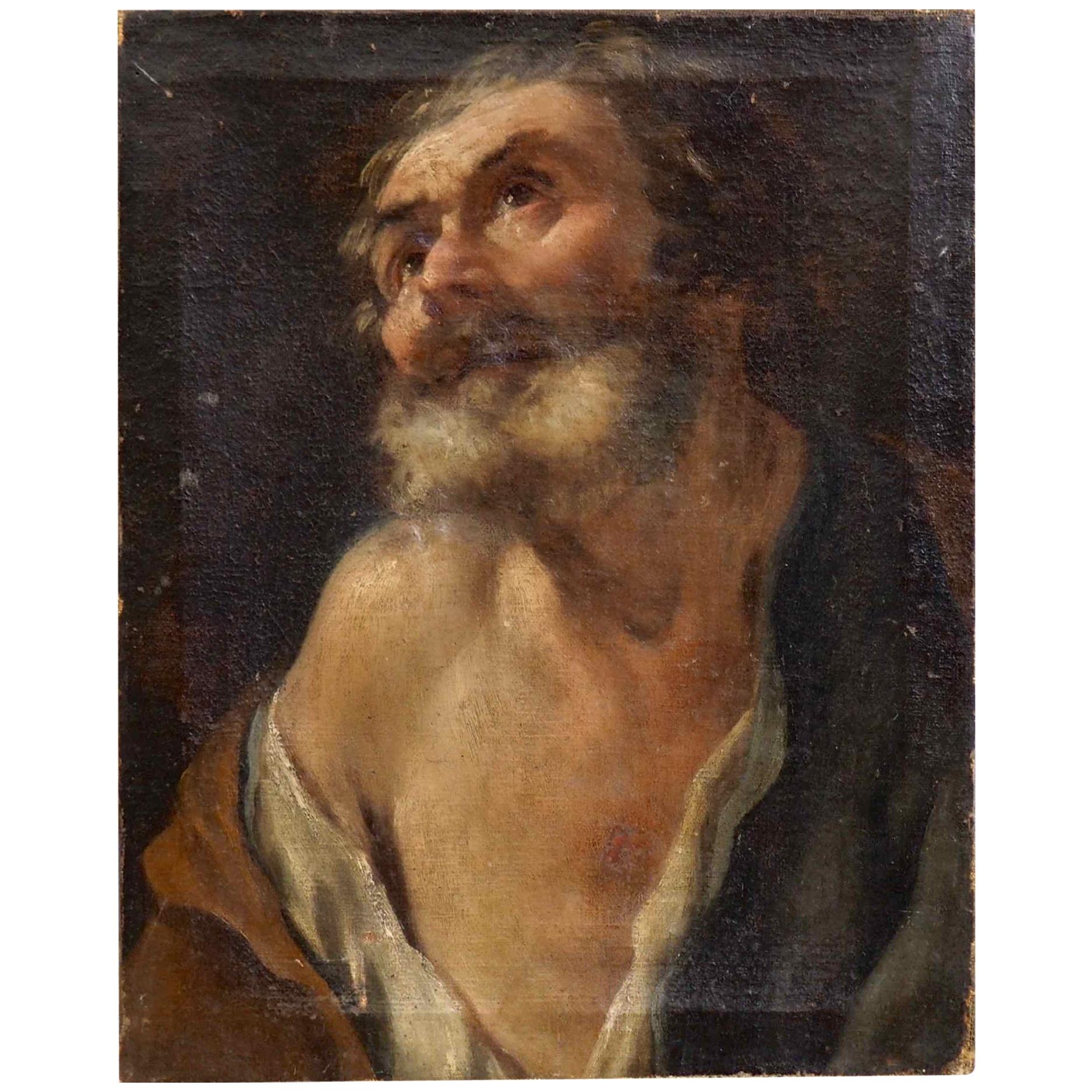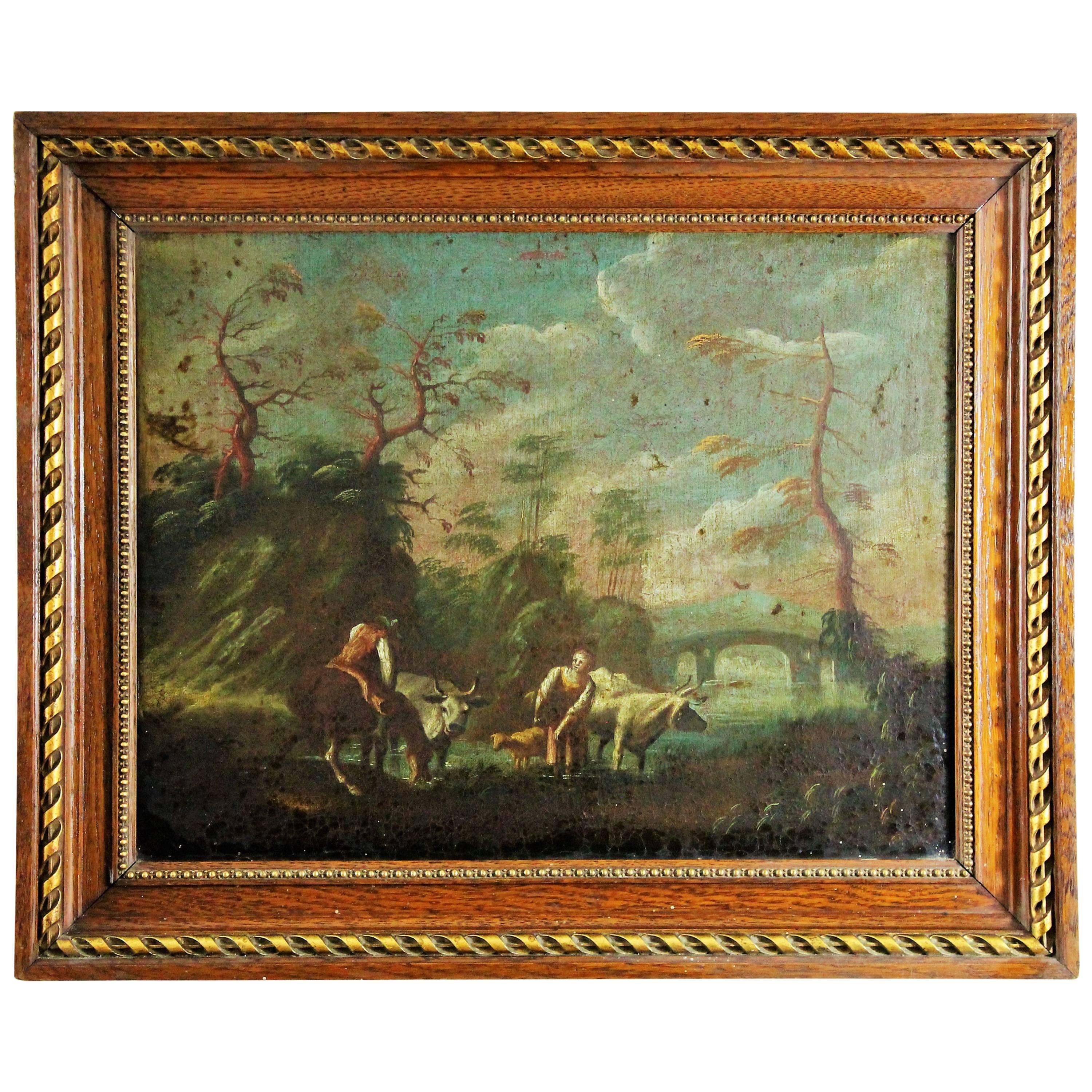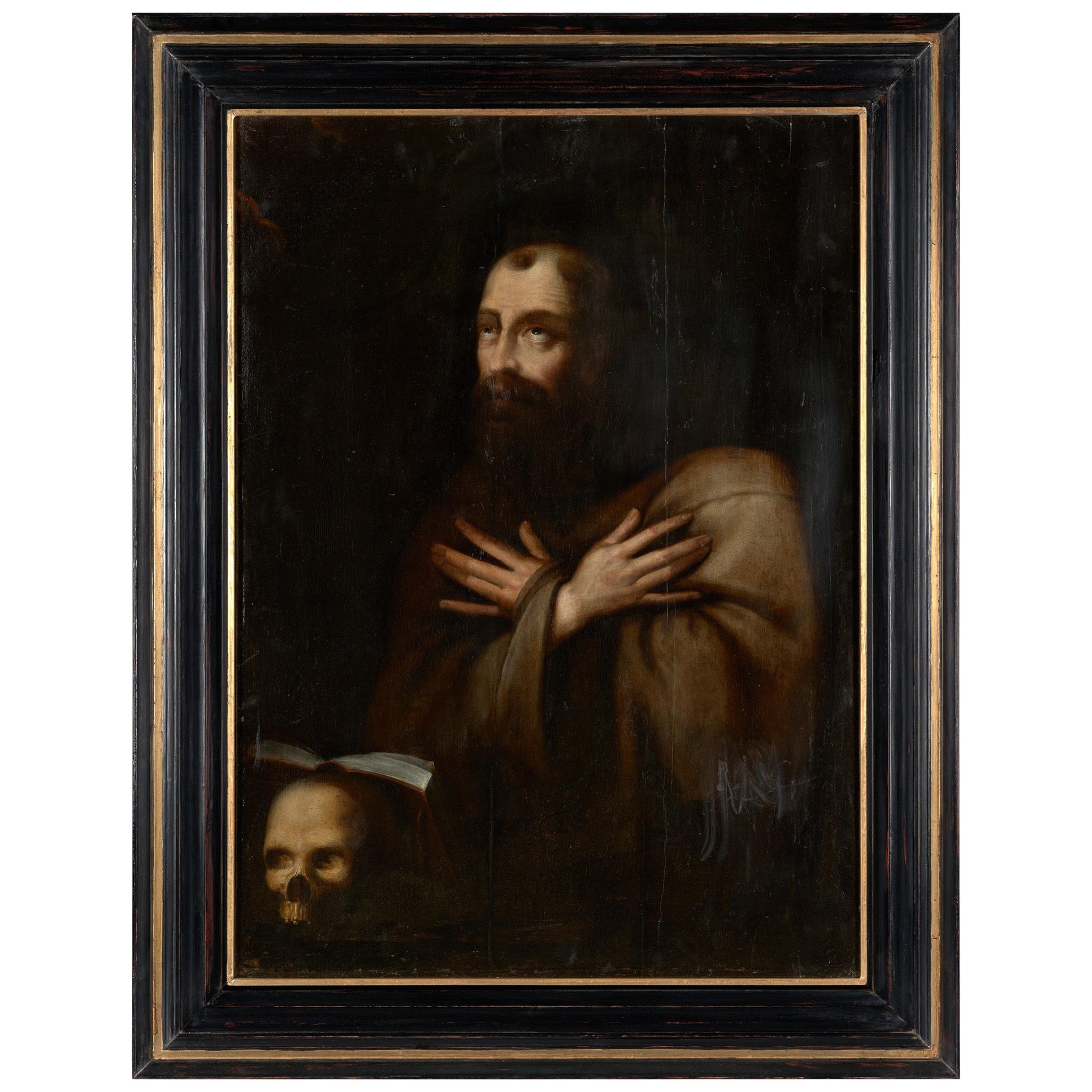Items Similar to 17th Century Saint Joseph Oil on Canvas Attributed to Antonio Cifrondi
Want more images or videos?
Request additional images or videos from the seller
1 of 10
17th Century Saint Joseph Oil on Canvas Attributed to Antonio Cifrondi
About the Item
Antonio Cifrondi (1665 - 1730), Attributed
Man with stick - Saint Joseph
Measures: Oil on canvas, Cm 115 x 79 - With frame, cm 139 x 103
This canvas is, for stylistic and compositional reasons, comparable to the works of the Bergamo painter Antonio Cifrondi (1665 - 1730).
Antonio Cifrondi is without any doubt one of the most important protagonists of Lombard painting between the seventeenth and eighteenth centuries; for Abbot Lanzi, Cifrondi was "the last of the Bergamasco of some merit in composing". Born in Clusone in the seventeenth century in the Seriana valley in the province of Bergamo, Antonio Cifrondi painted a large number of works alternating the sacred with the profane, with a late-Baroque style. According to sources (Tassi, 1793) he was put in the workshop of the mediocre painter Cavalier del Negro from Cluson, of which nothing is known. He then received a scholarship made available every year for three young poor Clusonesi who wanted to continue their studies in the liberal arts (Belotti, 1959). In Bologna he would have been a pupil of Marcantonio Franceschini: an echo of this attendance can be recognized in the David and Golia of the Chamber of Deputies; in 1679 his presence is documented in Rome, then perhaps in Naples, Turin and France between Grenoble and Paris, coming into contact with the painting of the great masters of the past, but also with the experiences of contemporaries. Back home around 1686, he worked feverishly until the end of his days in the Bergamo area, with a style recognizable for the lively use of color, the rapidity of brushstroke, the marked and almost macchiettistic characters of the characters while in the second part of his activity, starting from the early eighteenth century, the palette becomes poorer and the painting dedicated especially to depicting python, according to models very close to those of the young Todeschini. A peculiarity of his modus operandi was the speed of execution, made possible thanks to the naturalness and ease with which he performed the works. This allowed the execution of a large number of paintings, scattered in the provinces of Bergamo and Brescia.
The landscape and nature are almost absent in his painting while the focus is on the figure, which emerges from the neutral and dark background: large isolated figures occupy all the space (very often they are represented only three quarters of the figure); apostles or saints or popular characters stand on dark or reddish bottoms. Few are the colors used according to the predilection of Cifrondi for almost monochrome effects.
The man with the stick here portrayed, who could be read as a Saint Joseph, can be related to the paintings of popular characters preserved in the Pinacoteca Tosio Martinengo but the less caricatural character brings it closer to the figures of saints made by the painter such as Saint Paul of the Parish of Clusone or Saint Joseph in the Flight to Egypt and Saint Anthony the Abbot.
- Dimensions:Height: 54.73 in (139 cm)Width: 40.56 in (103 cm)Depth: 1.97 in (5 cm)
- Materials and Techniques:
- Period:
- Date of Manufacture:17th Century
- Condition:Refinished. Wear consistent with age and use. The painting has been cleaned.
- Seller Location:Milan, IT
- Reference Number:1stDibs: LU5918233526132

About the Seller
5.0
Vetted Seller
These experienced sellers undergo a comprehensive evaluation by our team of in-house experts.
Established in 2000
1stDibs seller since 2021
25 sales on 1stDibs
Typical response time: 12 hours
- ShippingRetrieving quote...Ships From: Milan, Italy
- Return PolicyA return for this item may be initiated within 14 days of delivery.
More From This SellerView All
- 17th Century Portrait of Saint Paul Painting Oil on Oval CanvasLocated in Milan, IT17th century Portrait of Saint Paul Measures: Oil on oval canvas, 67 x 50 cm - with frame 81 x 64 cm The portrait examined here depicts the Apostl...Category
Antique 17th Century Italian Paintings
MaterialsCanvas
- 17th Century Mystical Marriage of Saint Catherine Oli on Canvas Roman SchoolLocated in Milan, IT17th century, Roman School Mystical marriage of Saint Catherine of Alexandria Oil on canvas, 32 x 23 cm Frame cm 45 x 36 The saint is depicted in front of the Virgin holding th...Category
Antique 17th Century Italian Decorative Art
MaterialsCanvas
- 16th-17th Century Gentleman’s Portrait Oil on Canvas by Francesco ZuccoLocated in Milan, ITFrancesco Zucco (circa 1575-1627) Gentleman’s portrait Measures: Oil on canvas, cm 120 x 140 The painting analyzed here belongs to the pictorial production of Francesco Zucc...Category
Antique Early 17th Century Paintings
MaterialsCanvas
- 17th Century Madonna with Child Painting Oil on Canvas Tuscan SchoolLocated in Milan, IT17th century, Tuscan school Madonna and Child Oil on canvas, 31 x 21 cm With frame, cm 37,5 x 27,5 The pearly incarnations and the thoughtful play of looks between the Virgin, turned to the Son, and Questi, warmly open to the viewer, pour out the present painting with compositional perfection. Virginal fabrics become mottled at the folds, wrapping the Madonna in a thin vitreous mantle. The pastel colors, shining on the pink robe just tightened at the waist by a gold cord, enliven the faces of the divine couple in correspondence of the cheeks, lit by an orange warmth. Even the left hand of the Virgin, composed in perfect classical pose (Botticelli, Madonna with Child, 1467, Musée du Petit Palais, Avignon), is sprinkled with warmth thanks to the immediate touch with Christ. From the nimbus of the Mother a delicate luminous disk is effused, which takes back, in the most distant rays, the colour of the hair of the Son, from the tones of the sun. The Child Jesus is represented intent in a tender gesture of invitation with the right hand, while with the other he offers a universal blessing: with his hand he retracts the index and annular palms, extending the remaining three fingers, symbol of Father, Son and Holy Spirit. The painting welcomes and re-elaborates that typically Tuscan formalism that boasted in the rest of Italy the constant appreciation by the most up-to-date artists and collectors. Arrangement, composition and mixing of colors place the canvas in the middle between the changing mannerist and the sculptural figures of Michelangelo, essential yardstick of comparison in terms of anatomical and expressionistic rendering. In the present, silvery and pinkish powders act as three-dimensional inducers to the Child’s mentioned musculature and to the vivid folds of the clothes, expertly deposited on the lunar whiteness of the skins. While these colours recall the equally brilliantly transparent colours of Pier Francesco Foschi...Category
Antique 17th Century Italian Paintings
MaterialsCanvas
- 17th Century Angelica and Medoro Painted Oil on Canvas Roman SchoolLocated in Milan, ITRoman School, 17th century Angelica and Medoro engrave their names on the bark of a tree Oil on canvas, 65 x 48.5 cm The canvas depicts one of the most famous episodes of O...Category
Antique 17th Century Italian Paintings
MaterialsCanvas
- 17th Century Christ and the Samaritan Oil on Canvas Roman SchoolLocated in Milan, ITRoman school of the 17th century Landscape with bridge - Christ and the Samaritan woman at the well Oil on canvas, cm 42 x 59,5 - With frame, cm 54, 5 x 71 cm The small canvas portrays a broad view of the city surrounded by a bucolic and lush landscape, probably a reinterpretation of the Roman countryside or the Agro. The fulcrum of the canvas is the bridge consisting of several bays beyond which stands a village. In the distance the landscape made of green mountains opens into what looks like a lake crossed by boats. The landscape is animated by the human presence; not only small and fleeting figurines intent on walking along earthy paths but also the representation, in the foreground, of an Gospel episode, that of Christ and the Samaritan woman at the well. The landscape can be clearly traced back to a painter trained on the examples of the great seventeenth-century Roman baroque landscape that sees in the Lunette Aldobrandini by Annibale Carracci but also in Claude Lorrain, Nicolas Poussin and Gaspar Doghet are its greatest achievers. If in the past, therefore, the landscape was considered the scenic background on which to project the representation of divine or human characters, in the seventeenth century it became an autonomous and codified pictorial genre. With Carracci comes the so-called ideal landscape: a mental reconstruction of a peaceful and harmonious nature in which the dream of a perfect communion with man is realized. In the wake of Hannibal, as mentioned, during the seventeenth century the "classic" Roman landscape knows a long and happy season by artists such as Domenichino, and the French Claude Lorrain, Nicolas Poussin and Gaspar Dughet. Lorrain investigates the Roman countryside in all its aspects, studying the variations in the different hours of the day, the seasons or weather conditions, but always nourished by a sense of bucolic Virgilian. With Poussin the approach becomes intellectual elaboration and sophisticated rational construction. From the examples of the great masters, the Roman Baroque season, from the middle of the century, saw the flourishing of several personalities who, with shots, but also important personal reworkings, led to further spread the genre. Among the personalities that can be compared to the work in question we cannot fail to mention Crescenzio Onofri (1634-1714), defined by Salerno as the only true pupil of Dughet, who then spread in Florence the taste of the Baroque landscape influencing Tuscan painters such as Panfi and Peruzzini. His paintings are in various Roman collections; such as, for example, the landscapes from the Sacchetti Collection and today at the Pinacoteca Capitolina. and those in the Almagià collection in Rome, others in the Palazzo di Montecitorio, but the most conspicuous group is in the Galleria Doria. In comparison we can mention the two passages of the National Gallery in London, the landscape with a bridge over the Antiquarian Market but also the design of the National Gallery of Art in Washington. In the work you can also find the influences of the art of Giovanni Francesco Grimaldi...Category
Antique 17th Century Italian Paintings
MaterialsCanvas
You May Also Like
- Italian Old Master Painting, 17th Century, Oil on CanvasLocated in Aalsgaarde, DKItalian old master painting, 17th century, oil on canvas. Good condition Measures: H. 54 W. 43 cm H. 21.2 W. 16.9 in.Category
Antique 17th Century Italian Paintings
MaterialsPaint
- Oil on Canvas Paint Flemish School, 17th Century BelgiumLocated in Beuzevillette, FROil on canvas depicting a country scene: a man watering his horse near a river where two cows and a sheep wade accompanied by a farmer. Work of northern France or Belgium of the 17t...Category
Antique 17th Century Belgian Paintings
MaterialsCanvas
- 17th Century Flemish School, Saint Francis In Extasy, Oil on Oak PanelLocated in Leuven , BEThis 17th century panel painting is a depiction of a praying Franciscan monk, or of Saint Francis. The grey-brown habit, the skull and the book are ...Category
Antique 17th Century Belgian Decorative Art
MaterialsOak, Paint
- 19th Century Oil on Canvas Bacchante Group Attributed to Leopold SchmutzlerLocated in Los Angeles, CAA large 19th century oil on canvas Bacchante group depicting two allegorical young semi-nude maidens dancing with pan, attributed to Leopold Schmutzler...Category
Early 20th Century German Greco Roman Paintings
MaterialsCanvas, Giltwood
- 19th Century Oil on Canvas Painting Attributed to Eugenio Lucas VillamamilLocated in Marbella, ESAntique 19th century oil on canvas people painting attributed to Eugenio Lucas Villamamil, with acanthus and foliate gilt wood and gesso frame Dimensi...Category
Antique 19th Century Spanish Paintings
MaterialsCanvas
- 17th Century oil on canvas Josiah Childs attributed to John RileyLocated in Bakewell, GB17th Century oil on canvas Josiah Childs attributed to John Riley 138 x 116cms In original frameCategory
Antique 17th Century Paintings
MaterialsPaint
Recently Viewed
View AllMore Ways To Browse
Antique Quarters
Antique Measuring Stick
17th Century Early Baroque Painted
1793 France
Flight Egypt
Apostles Painting
Flight To Egypt
Flight Into Egypt
The Flight Into Egypt
Apostle Paul
Joseph Bologna
Antique Corner Glass Cabinet
Pair Of Louis Chest
Mid Century Door Commodes
Short Shelves
Wall Paper Rolls
German Maple Chairs
Inlaid Cabinet On Stand





